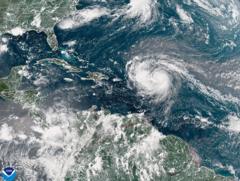Hurricane Erin has swiftly escalated to a category five hurricane, showcasing maximum sustained winds of 160 mph (260 km/h). During a recent briefing, Mike Brennan, director of the National Hurricane Center, noted the "extremely powerful" storm underwent "explosive deepening and intensification" during the night, transitioning from a tropical storm since Friday. Erin is anticipated to track northward of the Leeward Islands, Virgin Islands, and Puerto Rico over the weekend, bringing as much as 6 inches (15 cm) of rainfall which heightens the risk of flash flooding and mudslides in these areas. This storm marks the inaugural hurricane of the 2025 Atlantic season and is not predicted to make landfall on the mainland of the United States.
The rapid intensification phenomenon saw Erin's winds grow from 100 mph early Saturday morning to a formidable 160 mph. Looking ahead to next week, Erin is projected to make a gradual northward move, skirting to the east of the Bahamas and towards the Outer Banks of North Carolina. Life-threatening surf and rip currents are forecasted for almost the entire East Coast of the U.S., with Florida and mid-Atlantic states likely to experience the most perilous surf conditions. Bermuda may also encounter dangerous surf and heavy rainfall due to the hurricane's influence.
In response to gale force winds, the U.S. Coast Guard has enacted restrictions for vessels in ports at St. Thomas and St. John in the U.S. Virgin Islands, as well as six municipalities in Puerto Rico, including San Juan. The National Oceanic and Atmospheric Administration (NOAA) has warned that this year's Atlantic hurricane season is expected to be "above normal," forecasting an increase in the number of tropical storms reaching category four and five levels, a trend linked to global warming.
The rapid intensification phenomenon saw Erin's winds grow from 100 mph early Saturday morning to a formidable 160 mph. Looking ahead to next week, Erin is projected to make a gradual northward move, skirting to the east of the Bahamas and towards the Outer Banks of North Carolina. Life-threatening surf and rip currents are forecasted for almost the entire East Coast of the U.S., with Florida and mid-Atlantic states likely to experience the most perilous surf conditions. Bermuda may also encounter dangerous surf and heavy rainfall due to the hurricane's influence.
In response to gale force winds, the U.S. Coast Guard has enacted restrictions for vessels in ports at St. Thomas and St. John in the U.S. Virgin Islands, as well as six municipalities in Puerto Rico, including San Juan. The National Oceanic and Atmospheric Administration (NOAA) has warned that this year's Atlantic hurricane season is expected to be "above normal," forecasting an increase in the number of tropical storms reaching category four and five levels, a trend linked to global warming.


















